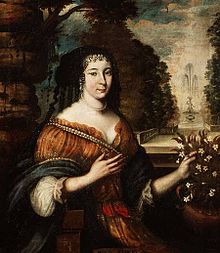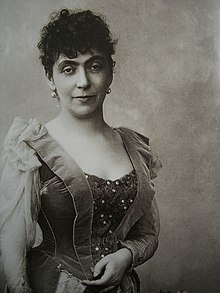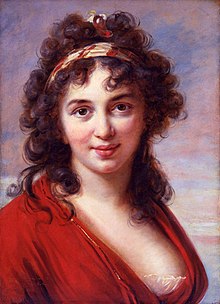Literary Salon

A literary salon was a mostly private social meeting place for discussions, readings or musical events from the 18th to the 20th century. In addition to literary and other artistic salons, there were also political ( Spitzemberg , Treuberg ) and scientific ( Helmholtz ) salons. Sponsors included individual patrons or associations . Above all, wealthy and educated women, often of noble origin, acted as hostesses and were called salonnière in this capacity .
story
The forerunners of the early modern salons can be seen in the courts of the muses of Isabella d'Este or Emperor Friedrich II . In France, a style-defining salon culture was found as early as 1600 under the conditions of absolutism and the civilizational counter-movement after the brutalization of the Huguenot wars . The departure of the aristocracy from their rural dominions into the sphere of influence of the king promoted the emergence of aesthetic circles in Paris, which saw themselves as an expression of the new culture of conviviality . Numerous aristocratic palaces were built in Paris and, in exchange for bourgeois lifestyles, transformed into literary salons or the more intimate ruelle ("little room"); so-called preciousness was considered the highest or exaggerated expression of the cultural refinement of the time . The salon served the free exchange of ideas, regardless of class and gender barriers, and promoted the Enlightenment . Philosophers like Voltaire or Diderot frequented the Paris salons and there prepared the ground for the French Revolution .
In 18th-century Germany, the literary salon came into fashion as a place for bourgeois socializing, originally in imitation of court manners . The " Weimar Musenhof " had been idealized since the late 19th century, but the nobility tended to withdraw from the activities of the commoners. The early romantic salons became famous , for example Caroline Schelling 's Jena salon and Rahel Varnhagen 's Berlin salon . In the Biedermeier period , they were signs of a bourgeois retreat into the private sphere. These salons often served to promote young talents in literature and music. The meetings of friends around Franz Schubert in Vienna in the 1820s were a kind of musical-literary salon , the so-called “ Schubertiaden ”. After the First World War , they went out of fashion or became part of a fashionable entertainment culture. With formats such as the Kunstsalon Köln and the international SalonFestival, the commitment is revived through readings, musical events and discussions in the private houses of the cities.
Salons in the Danish language area
- Friederike Brun , Sophienholm near Copenhagen
Salons in German-speaking countries


-
Berlin
- Elisa von Ahlefeldt
- Edith Andreae
- Bettina von Arnim
- Gisela von Arnim
- Bertha von Arnswaldt
- Caroline Bardua
- Maria Beccadelli of Bologna
- Sophia Becker-Leber
- Amalie Beer
- Luise Begas Parmentier
- Amalie Henriette Caroline of Beguelin
- Caroline Friederike von Berg
- Carl and Felicie Bernstein
- Marie von Bunsen
- Henrietta von Crayen
- Johanna Dieffenbach
- Rebecka Dirichlet
- Viktoria von Dirksen
- Rebecca Friedlander
- Marie Anne von Goldschmidt Rothschild
- Sophie Leopoldine Wilhelmine von Grotthuis
- Anna von Helmholtz (focus: science)
- Double salon (Focus: natural sciences with Marcus Herz and culture and philosophy with Henriette Herz )
- Elise von Hohenhausen
- Elise Rüdiger , guests and others Annette von Droste-Hülshoff
- Helene von Huelsen
- Caroline von Humboldt
- Amalie von Imhoff
- Hartmut Fischer Juliette's Literature Salon
- Marie von Kleist
- Dorothea of Courland
- Helen von Lebbin
- Sabina Lepsius
- Sarah Levy
- Fanny Lewald
- Caroline de la Motte Fouque
- Helene von Nostitz
- Hedwig von Olfers
- Marie von Olfers
- Maximiliane, Countess of Oriola
- Anna vom Rath
- Louise of Radziwill
- Marie von Radziwiłł
- Cornelie Richter
- Mathilde von Rohr
- Sophie Sanders
- Marie von Schleinitz (who also ran salons in Saint Petersburg and Paris during her stay there ; focus: art and music)
- Emma Siegmund
- Emma Simon
- Jette Solmar
- Nicholas Sombart
- Hildegard von Spitzemberg (political salon)
- Elisabeth von Staegemann
- Hetta Countess Treuberg (political salon)
- Rachel Varnhagen
- Ernestine von Wildenbruch (political salon)
- Bern
-
Bonn
- Johanna Kinkel (musical salon)
- Sibylle Mertens-Schaaffhausen (archaeological-artistic salon)
-
Dresden
- Christian Gottfried Körner (guests include writers and painters such as Friedrich Schiller , Heinrich von Kleist and Dora Stock )
- Dusseldorf
- Ehrenbreitstein
- Eisenach
- Geneva
- Graz
- Good Emkendorf
-
Hamburg
- Elizabeth Campe
- Charlotte Embden (Heinrich Heine's sister)
- Elise Reimarus
- Jena
- Karlsruhe
- keel
- Koenigsberg
- Leipzig
- Lucerne
- Luebeck
- Manheim
- Merano
-
Munich
- Elsa Bernstein and Max Bernstein
- Hugo Bruckmann and Elsa Bruckmann
- Gaby Dos Santos (musical-artistic jour fixe )
- Hertha Koenig
- Marianne von Werefkin
- Therese of Bavaria (scientific salon)
-
Muenster
- Amalie von Gallitzin (religious salon; the Munstersche Kreis )
-
Nordhausen
- Julie Johanne Caroline von Saalfeld (sister of Wilhelm Gesenius) (religious salon, guests included Johann Hinrich Wichern )
- Prague
- to reprimand
-
Stuttgart
- " Hartmann-Reinbeck's house "
- a) by Johann Georg Hartmann
- b) by August von Hartmann (son of a)
- c) by Emilie Reinbeck , née Hartmann (wife of d)
- d) by Georg von Reinbeck (b's son-in-law)
- Emilie Vollmoeller
- " Hartmann-Reinbeck's house "
- Weimar
-
Vienna
- Fanny von Arnstein
- Eleonora Fugger von Babenhausen
- Pink by Gerold
- Henriette von Pereira-Arnstein
- Gina Kaus
- Marie Lang
- Eleanor of Liechtenstein
- Lina Loos
- Alma Mahler Werfel
- Anna Mahler
- Wilhelmine Dorothee von der Marwitz
- Pauline Metternich
- Maria Theresia Paradis (musical salon)
- Caroline Pichler
- Nannette Streicher (musical salon)
- Sophie von Todesco in the monumental Palais Todesco
- Josephine von Wertheimstein
- Greta Wiesenthal
- Eugenie Schwarzwald
- Berta Zuckerkandl
- Zurich
- Luxembourg
Salons in French-speaking countries
- 17th century (see also the article Preciousness ):
- 18th century:
- Sophie Arnold
- Sophie Lalive de Bellegarde
- Elisa Bonaparte
- Emilie du Chatelet
- Madame du Deffand
- Marie Anne Doublet
- Madame Claude Dupin
- Claire de Duras
- Marie Duronceray
- Madame d'Epinay
- Madam Geoffrin
- Francoise de Graffigny
- Catherine Grand
- Madame Helvetius
- Julie de Lespinasse
- Marquise de Lambert
- Elżbieta Izabela Lubomirska
- Marshal de Luxembourg
- duchess du maine
- Madame Necker
- Juliette Recamier
- Madame Roland
- Françoise Eléonore Dejean de Manville, Comtesse de Sabran
- Madame de Staël
- Madame de Tencin
- 19th century:
- Juliet Adam
- Marie d'Agoult
- Alice Pike Barney
- Fanny de Beauharnais
- Valtesse de la Bigne
- Mathilde Bonaparte
- Theresia Cabarrus
- Marguerite Charpentier
- Mary Anne Clarke
- Louise Colet
- Alphonse Daudet
- Marie-Anne Detourbay (Comtesse de Loynes)
- Helene de Gingins
- Genevieve Halevy
- Marie Anne Pierrete Paulze Lavoisier
- Madeleine Lemaire
- Auguste Leo
- Dorothea von Lieven (born von Benckendorff)
- Leontine Lippmann
- Stephane Mallarme
- Elise de Perthuis
- Cafe de Procope
- Melanie Renouard de Bussiere
- George Sand
- 20th century:
English salons and coffee houses
- Sarah Austin , Queen Square (Westminster)
- Bloomsbury Group
- Mary Boyle, Countess of Cork and Orrery
- Button's Coffee-house , London
- Jane Welsh Carlyle
- Georgina Cavendish, Duchess of Devonshire
- The Grecian , London
- Hortensia Mancini , London
- Elizabeth Montagu
- Will's Coffee-house , London
Italian salons
- Isabella Albrizzi-Teotochi
- Casa Buti
- Marina Querini Benzon
- Giustina Renier Michiel
- Sarah Copia Sullam
- Cristina Trivulzio Belgiojoso
- Giustiniana Wynne
Polish salons
Russian salons
- Avdotya Yakovlevna Panayeva
- Lidija Zinovjeva-Annibal (literary-philosophical salon)
Swedish salons
Spanish salons
American salons
More lounges
- Ludmila Assing
- Axel Brauns
- Out el-Kouloub
- Daisy Fellowes
- Martin Jankowski (the " Literatursalon am Kollwitzplatz " for the literary magazine ndl )
- Maria Kessler
- Malwida from Meysenbug
- Charles Nodier
See also
literature
- Petra Dollinger: Salon , in: European History Online , ed. from the Institute for European History (Mainz) , 2017, accessed 8 March 2021 ( pdf ).
- Günter Erbe : The posh Berlin . Princess Marie Radziwill and the great ladies of society 1871-1918. Böhlau Verlag , Cologne/Weimar/Vienna 2015, ISBN 978-3-412-22457-8 .
- Heinz Gerstinger : Old Viennese literary salons. Viennese salon culture from Rococo to Neo-Romanticism (1777–1907). Academic publishing house, Salzburg 2002, ISBN 3-9501445-1-X .
- Milan Dubrović : Misappropriated History. The Viennese Salons and Literature Cafes . Frankfurt am Main 1985, ISBN 3-552-03705-5 .
- Albert Kaltenthaler: The Paris Salons as European Cultural Centers. With special reference to the German visitors during the period 1815-1848 . Dissertation WiSo Nuremberg June 15, 1960.
- Renate Baader : Dames de lettres. Authors of the precious, highly aristocratic and “modern” salon (1649–1689) , Metzler, Stuttgart 1986, ISBN 3-476-00609-3 (= Romance Studies , Volume 5; also habilitation thesis at the University of Saarbrücken 1984)
- Verena von der Heyden-Rynsch: European salons. Highlights of a sunken female culture. Artemis & Winkler, Munich 1992, ISBN 3-7608-1942-7 .
- Claudia Lillge: "The tones of love were imitated". Reflections on love and salon conviviality with special reference to the 19th century. In: Werner Faulstich , Jörn Glasenapp (eds.): Love as a culture medium. Fink, Munich 2004, ISBN 3-7705-3657-6 , pp. 57–80.
- Wolfgang Martynkewicz: "Salon Germany". Spirit and Power 1900–1945. Structure, Berlin 2009, ISBN 978-3-351-02706-3 .
- Peter Seibert: The literary salon. Literature and Society between Enlightenment and Vormärz. Metzler, Stuttgart 1993, ISBN 3-476-00943-2 .
- Petra Wilhelmy-Dollinger: The Berlin Salons. Walter de Gruyter. Berlin 2000, ISBN 3-11-016414-0 (former title: The Berlin Salon in the 19th Century. 1780–1914 ).
- Ingeborg Drewitz: Berlin Salons. Society and literature between the Enlightenment and the industrial age. 3rd edition, Haude and Spener, Berlin 1984, first edition 1979, ISBN 3-7759-0199-X (= Berlinische Reminiszenzen. Band 7).
- Cornelia Saxe: The sociable canapé - The renaissance of Berlin salons , Ullstein, Berlin 1999, ISBN 3-88679-331-1 .
- Ernst Siebel: The bourgeois salon: 1850-1918. Reimer, Berlin 1999, ISBN 3-496-01200-5 .
- Deborah Hertz: The Jewish Salons in Old Berlin. dtv, Munich 1995, ISBN 3-423-30446-4 .
- Helga Peham: The salonières and the salons in Vienna. 200 years of history of a special institution. Styria, Graz 2013, ISBN 978-3-222-13402-9 .
- Rainer Schmitz (ed.): Henriette heart in memories, letters and testimonies. Berlin 2013, Verlag AB – The Other Library , ISBN 978-3-8477-0347-1 .
- Hadumod Bussmann : "I was not afraid of anything in life". The Unusual Story of Therese Princess of Bavaria. 2nd edition, Beck, Munich 2013, ISBN 978-3-406-61353-1 .
- Ines Böhner (ed.): Femmes fatales. 13 approaches. [u. a. Lidija Zinovjeva-Annibal]. Bollmann, Mannheim 1996, ISBN 3-927901-78-4 .
web links
- Emile Zola's Criticism of the Salons (1866)
- Beginnings of the salons from 1610 and their predecessors (PDF file; 41 kB)
- salon culture
itemizations
- ↑ Charles-Augustin Sainte-Beuve portrayed French salon culture in a masterly fashion : People of the XVIII. century. Translated by Ida Overbeck, initiated by Friedrich Nietzsche. Newly edited by Andreas Urs Sommer with newly discovered notes by Ida Overbeck . The Other Library, Berlin 2014, ISBN 978-3-8477-0355-6 .
- ↑ Idea and Goal , on salonfestival.de














